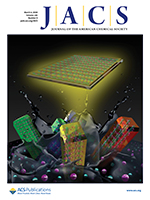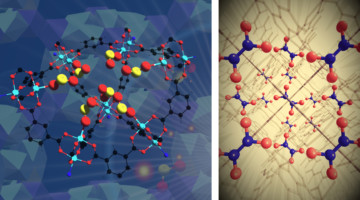Burning of natural gas at oil and gas wells, called flaring, is a major waste of fossil fuels and a contributor to climate change. In this work, researchers synthesized and characterized a metal-organic framework that uses biomimetic chemistry to convert wellhead gases into economically valuable feedstocks for petrochemical products. Read more »
Articles featuring Beamline 11.3.1
Optical sensing of aqueous nitrate anion by a platinum(II) triimine salt based solid state material
Researchers present a new Pt(II) salt that enables the selective and quantitative measurement of aqueous nitrate anions without the need for pH adjustment. The method relies on the color change of the Pt(II) complex from yellow to red and an intense luminescence response, simplifying the detection process for on-site applications and expanding its applicability to broader matrices. Read more »
Valence tautomerism in a cobalt-verdazyl coordination compound
Valence tautomerization in inorganic chemistry typically involves the distribution of electrons between a metal center and redox active ligand, with potential application as molecular switches or other molecular devices. Here we report an example of valence tautomerization and an unusual electronic structure in a cobalt verdazyl complex. Read more »
Magneto-structural studies of an unusual [MnIIIMnIIGdIII(OR)4]4− partial cubane from 2,2′-bis-p–tBu-calix[4]arene
TBC[4] is a molecular framework that has proven to be a highly versatile ligand for the synthesis of a breadth of polymetallic transition metal, lanthanide metal, and 3d–4f complexes. We outline the synthesis, structure and magnetic behaviour of a new bis-TBC[4]-supported complex, together with theoretical magneto-structural studies examining the exchange interactions. Read more »
Time‐Dependent Cytotoxic Properties of Terpyridine‐Based Copper Complexes
The cover feature picture shows the progressive activation of terpyridine‐based copper(II) compounds that are not cytotoxic against various cell lines after 24 h of incubation but become highly efficient after 72 h of incubation, with IC50 values in the low‐micromolar to nanomolar range. Read more »
Divergent Adsorption-Dependent Luminescence of Amino-Functionalized Lanthanide Metal–Organic Frameworks for Highly Sensitive NO2 Sensors
A novel gas-sensing mechanism exploiting lanthanide luminescence modulation upon NO2 adsorption is demonstrated. Two isostructural lanthanide MOFs are used, including an amino group as the recognition center for NO2. Energy transfer from the ligands to Ln is strongly dependent on the presence of NO2, resulting in an unprecedented photoluminescent sensing scheme. Read more »
Blending Ionic and Coordinate Bonds in Hybrid Semiconductor Materials: A General Approach toward Robust and Solution-Processable Covalent/Coordinate Network Structures
Blending ionic and coordinate bonds in copper iodide based hybrid semiconductor materials with extended covalent/coordinate network structures leads to greatly enhanced solubility and solution processability, making it possible to form high-quality films for device fabrication. Read more »
Turning Up the Heat on Antibacterial-Resistant Diseases
Scientists have designed a biocompatible polymer that has the potential to advance photothermal therapy, a technique that deploys near-infrared light to combat antibacterial-resistant infections and cancer. The team synthesized the polymer by stringing together small molecules called ionic azaquinodimethanes, which they characterized at the ALS. Read more »
Crystallography Reveals How New Molecular Cages Trap Toxic Gases
Current technologies for reducing toxic gas emissions are often ineffective and wasteful. Crystallographic analyses of two new MOF materials revealed how they reversibly bind their target gases, enabling the materials to be reused over many cycles (reducing waste) and permitting subsequent conversion of the gases into valuable chemical products. Read more »
New MOF Can Take On Toxic Sulfur Dioxide Gas
An international team has developed a robust material that can selectively take in toxic sulfur dioxide gas at record concentrations and preserve it for use in chemical production. The researchers verified its performance using a combination of techniques that included x-ray experiments at the ALS. Read more »









